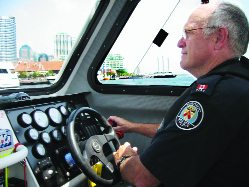By Dennis Hanagan –
 Constable Gary Gibson has concise advice for people heading to Lake Ontario for a day by the water—“never go near the water by yourself.”
Constable Gary Gibson has concise advice for people heading to Lake Ontario for a day by the water—“never go near the water by yourself.”
Gibson’s a 34-year veteran of Toronto Police Services. He’s been with its marine unit 14 years, half that time with the dive team, so he knows water can be fun but it can also be dangerous.
Gibson and his police unit have a lot to deal with on the city’s waterfront while on patrol.
The unit has 11 boats and covers 400 square miles between Peel and Durham regions and 11 miles out on the lake to the Canada-U.S. border.
Some of its search and rescue vessels can achieve 100 km an hour and sometimes assist other police forces that require extra manpower, boats, or a special piece of TPS marine equipment.
“It all depends on the availability of boats and equipment,” says Gibson, who’s assisted with water calls as far away as Bowmanville, up the Niagara River, and with the U.S. coast guard. On the dive team he’s been summoned to Lindsay and Port Perry on police matters.
On average, the unit receives 10 to 15 rescue calls a week—boaters out of gas, mechanical failure, a vessel blown ashore.
As for the harbour being a port for drug smuggling, Gibson says the percentage of cases of that “is very small.” However he did say a U.S. boater unsuccessfully tried smuggling 100 bottles of whisky through Toronto Harbour last summer.
Gibson recalls a drowning case last year in which a university student was walking alone near a sheer edge at Ontario Place. Police believe he slipped and fell into the lake and was unable to pull himself out.
That’s what Gibson means when he says always be with a companion who can offer help.
An average of 30 bodies are found annually in the harbour, a result of accidents, suicides and death by misadventure, says Gibson.
Something people may not realize is how cold harbour water can be, even in summer. While the upper foot or so can be 20 celsius, down around the waist and lower it’s hypothermic, says Gibson.
Another mistake people make is thinking they’ll keep warm by treading water. But that lets body heat escape through the groin and armpits, which lowers body temperature.
If you wind up in the water it’s best to huddle and seal off those areas, says Gibson. “The less you move the more you retain your heat.”
The best thing of course is to always wear a life jacket. With one a person can last three to four hours in the water, says Gibson. Without one “you may last an hour.”
 TheBulletin.ca Journal of Downtown Toronto
TheBulletin.ca Journal of Downtown Toronto

